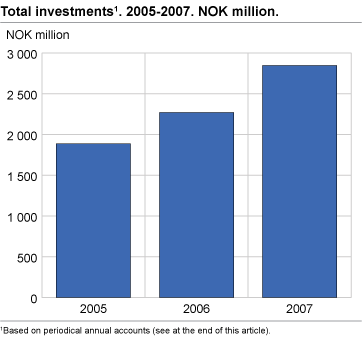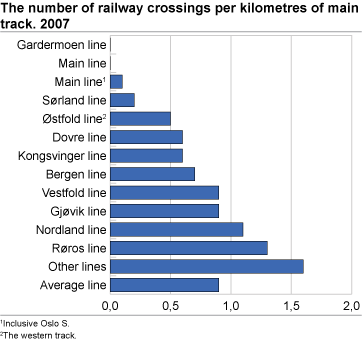Content
Published:
This is an archived release.
Increased investments in the rail network
Government investments in the rail network totalled NOK 2.8 billion in 2007, an increase from 2005 of almost NOK 1 billion, or 50 per cent.
There was also considerable growth in investments from 2005 to 2006, with NOK 385 million, or 20 per cent.
Operating expenditures constituted NOK 3.8 billion in 2007. The amount was 18 per cent higher than in 2005.
A total of 2 800 man-years were carried out in 2007 in governmental activity within administrating the railway infrastructure, the operational management of trains and assigning routes. The change in man-years from 2005 to 2007 was minor.
NOK 25 billion in assets
Government assets in the public-owned rail network represented an accounting value of almost NOK 25.1 billion in 2007. This was an increase of NOK 4 billion compared to 2005, or 19 per cent.
Little more than 4 100 kilometres of railway track
Regular traffic travels on 3 900 kilometres of the track. The Nordland line is the longest with 734 kilometres of track. This track is not electrified. A total of 62 per cent of the Norwegian track is electrified. Few other countries in Europe have a greater share of electrified track.
Fewer railway crossings
About 3 800 level crossings were registered in 2007, a decrease of 350 (8.5 per cent) from 2005. The Nordland line had most of the railway crossings, with 789 in 2007. This corresponded to 1.1 railway crossings per kilometre of track. The last two railway crossings were removed on the Drammen line in 2005 and the Gardermoen line has been free of railway crossings since it was opened. Nine per cent of the railway crossings were supplied with lights and barriers in 2007.
Safety
The risk of being killed or injured in a rail accident is rather limited in Norway. Since 2001, three people have been killed in such accidents each year on average. In a 20-year perspective, the average number of people being killed yearly is decreasing.
Reduced punctuality in 2006 and 2007
Punctuality fell from 2005 to 2007. For the passenger traffic in particular, the long distance trains experienced more delays. The local traffic in Oslo also had a negative development from 2005 to 2007. Of all the railways, the Gjøvik line and the Flytoget (airport express) had the highest punctuality with about 95 per cent of the trains running to schedule in 2007.
Only 77 per cent of all goods trains arrived at their destination within six minutes of schedule in 2007, a fall from 85 per cent in 2005.
The extreme weather in 2006 and 2007 with substantial quantities of both rainfall and wind, must be taken into consideration when evaluating the negative development in punctuality for these years. Additionally, the railway in the Oslo area suffered from infrastructure faults in 2007. This had an impact on both punctuality and regularity.
Railway infrastructure administratorUntil 1996, both the administration of the railway infrastructure and train transport were placed under the public management company Norwegian State Railways. This company was subsequently split in two: The administrative body Norwegian National Rail Administration and the public-owned company Norwegian State Railways plc (which changed to a private limited company as of July 2002). Norwegian National Rail Administration is responsible for administrating the railway infrastructure, the operational management of trains and assigning routes. The enterprise was included in StatRes in 2008. AllocationsThe activity of the Norwegian National Rail Administration is entirely based on governmental allocations. Periodic annual accountsThe Norwegian National Rail Administration is involved in a pilot project to develop periodic annual accounts for public enterprises. The project is managed by The Ministry of Finance. The Norwegian National Rail Administration has kept accounts since 2005 based on the preliminary standards developed for these types of accounts (in addition to keeping the normal cash flow accounting). The figures referred to in this article are in accordance with the periodic annual accounts. In cash flow accounting, the expenditures and earnings are reported on the settlement date, while in periodic accounts, the expenditures are charged when they are incurred and the revenues when they are earned. The governmental activity within administrating the railway infrastructure, the operational management of trains and assigning routes forms part of StatRes - State resource use and results. The purpose of StatRes is to show the level of resources that the state uses, what this input provides in terms of activities and services in the various government activities, and what outcomes can be seen from the input. Its aim is to provide the general public and the authorities with more knowledge of state-run activities. |
Find more figures
Also find statistics about the quality of the track, number of stations, platforms, tunnels and bridges.
Additional information
The statistics give an overview of the amount of resources the Norwegian National Rail Administration spends on administrating the infrastructure, the operational management of trains and assigning routes, and the results of the effort.
Contact
-
Statistics Norway's Information Centre
E-mail: informasjon@ssb.no
tel.: (+47) 21 09 46 42


